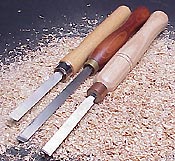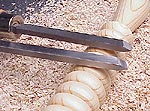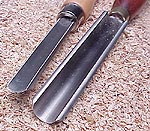 |
Making new handles (right) improved the performance of the stock Jet chisels (left), but they still are no match for the Crown (middle) chisels.
Click image to enlarge |
Woodturning Tools
Is better really better?
Text and photos by Tom Hintz
While researching the purchase of my Jet JWL-1236 woodworking lathe, many who offered advice on lathes also suggested getting a set of quality turning chisels. My Jet lathe included a free set of turning tools, a promotion at the time, but the advice regarding quality chisels stuck. I have long believed that high-quality tools usually have qualities that make them more effective, often easier to use, and that justify the larger initial cost.
I added a Crown five-piece beginners set of HSS (High Speed Steel) turning tools to the pile when buying the lathe. The set included a 3/8" spindle gouge, ¾" roughing gouge, ½" skew chisel, ½" round nose scraper, and a ¼" parting tool. This selection has proven to be very capable for nearly all of my turning projects with the understandable exception of hollowing and internal bowl tasks.
The free set from Jet included 3/8, ¾ and 5/8" gouges, 1, ½" skews, ½" round-nose scraper, 3/16" parting tool, and a V-tool.
The Jet chisels were made from tool steel, a material used to make turning chisels for years. Today however, HSS is considered the metal of choice by many experienced turners.
The new kid on the block in chisel materials is powdered metal, (PM) a technology used in the aerospace and other industries for decades. I have not heard much from wood turners about PM, probably because it is relatively new in this application.
As with most turning tools, both the Crown and Jet chisels required honing before use, a very important preparation, but one few novice turners are equipped to do. I bought an oilstone and produced reasonable edges by hand, but would soon add a Tormek SuperGrind that improved the edges on my chisels dramatically.
First Turnings
I decided to use the Jet tools for the first turnings, thinking my non-existent chisel handling skills might produce undesirable events that could be harmful to the tools, not to mention the wood, and possibly me. Jeopardizing the "good" chisels could wait until a little chisel-to-wood experience reduced the frequency and/or severity of those errors. Though apparently logical, this decision may have slowed the learning process.
As expected, my early turning attempts were accented by occasional "catches" and other surprising occurrences. Eventually, when these problems failed to diminish as quickly as anticipated, I began wondering if the Crown chisels had characteristics that might be of help.
With a fresh blank in the lathe, and a Crown chisel in hand, I began a new turning. My skill level jumped a notch or two, and the frequency of catches diminished in about the same proportion. I was doing better with the Crown chisels, and I had an idea why.
The Crown chisels felt better in my hands, primarily because their handles are contoured where the Jet handles are straight. As my experience grew, I recognize that the Crown tools also stayed sharper longer, reducing mistakes induced by fighting a dull edge. Eventually, I learned to recognize how my tools felt as their cutting edges began to go dull.
This is an important point for new turners, most of whom will suffer the same ignorance of what a dull versus sharp tool feels like. Dull tools are harder to control, make learning tougher, and mistakes easier. When in doubt, touch up the cutting edge.
Metal Differences
 |
Though appearing very similar, the Crown skew chisel (front) is made from thicker steel, which helps it resist flexing and vibration, both bad things on the lathe.
Click image to enlarge |
The difference between tool steel and HSS in turning chisels is important. Either metal can take a relatively sharp cutting edge, though most experienced turners think HSS is capable of achieving a more refined cutting edge. However, HSS enjoys a marked advantage because it retains a sharp edge much longer than tool steel. Both metals require accurate grinding and honing to produce a good cutting edge, but there are other differences.
Tool steel is far more sensitive to heat than HSS, requiring extreme caution when grinding or sharpening. Overheat tool steel and the tempering can be altered enough to further reduce its ability to hold a sharp edge.
There is also an important difference in the thickness of metal used to make similar chisels in these two sets. Both the Crown and Jet sets included ½' skew chisels. The Jet skew is made from tool steel that is 0.2030" thick, while the Crown HSS version of the same tool used 0.2380" material, 0.0350" thicker. That may seem like a small difference, but in use, the additional thickness is important. The thicker HSS is more rigid, a virtue in turning chisels that helps minimize flex and vibration, both of which contribute to rough surfaces and catches.
The Jet chisels are shorter (specifically the metal outside the handle) by about 2", than my Crown chisels with similar edge designs. While this difference may not be crucial in many situations, I believe the extra length, and the leverage it affords, is partially responsible for the better feel of the Crown chisels.
Design Differences
 |
Both are gouges, but the Crown in the foreground shows far more manufacturing steps and design features that increase cost, but performance is enhanced as well.
Click image to enlarge |
There is also a marked difference in chisel design between the Crown and Jet sets. A skew is a skew in most cases, but lay the gouges side-by-side and the difference is obvious. The Jet gouge is much flatter than the Crown. I suspect the Jet design is much easier to manufacture, an important consideration when trying to maintain a low price point. The Crown gouge obviously requires several more machining steps, and considerably more material.
In use, either gouge removes material, but the Crown gouge does it easier, with more control, and produces a much smoother surface. Here again, the HSS in the Crown gouge allows it to stay sharp much longer while roughing in a new blank, an operation that is very tough on the tool.
Handles
The most visible difference between the Crown and Jet chisels is their handles. The Jet handles are straight where your hand grips them while the Crown handles have a contour that feels much better to me. Both handles are roughly the same length.
Since chisel handles are turned, and I had a new lathe, I decided to make new handles for the Jet chisels to see how that affected their performance.
 |
My custom turned handles (foreground) felt much better than the straight ones that came with the Jet chisels. The better feel allowed better control, and better results, but still not matching that of the Crown set.
Click image to enlarge |
My handles were turned from 1 ½" square by 11" long red oak blanks. The new handles are 2" longer than the originals to bring the final length close to that of the Crown set.
I turned a contour into my new handles similar to those in the Crown set, but enlarged slightly to better fit my hand.
Ferrules for the custom handles were fashioned on my lathe using a shop-made, oak mandrel. (See my story on the mandrel) The chisel tangs are driven into 5/16" holes, drilled to a 3" depth on the lathe using a chuck and brad point bit.
The Results
The combination of my custom turned handles, and improved sharpening capabilities gave the Jet chisels a substantially better feel that made them easier to use. How much of the improvement can be attributed strictly to these modifications rather than my improving skills at the lathe is difficult to quantify. I am sure both had an impact, but I can say that the Jet tools felt better the instant the custom handles were installed.
I still prefer the Crown chisels, and use them most often on the lathe. I sometimes use the large skew, and V-cutter from the Jet set, but the rest seldom see the lathe up close. I have re-ground two of the Jet chisels, making a straight scraper and a beading chisel, which also see occasional use.
I have heard from relatively new wood turners who are successful with the Jet chisels, and that should not be surprising. An interest in woodturning does not override natural skills or individual tastes. Some turners will like the feel of the Jet chisels, others will not. However, I think a larger number of turners will gravitate towards the Crown and Sorby level of chisels.
If I were buying my first lathe today, I would once again include a set of quality chisels. For me, the difference in feel, control, and results is substantial, and worth the extra money. I am convinced they have reduced the steepness of my learning curve, and will continue to do so in the future as my still fledgling turning skills improve.
For more info on the Crown chisel set, Click Here.
|




